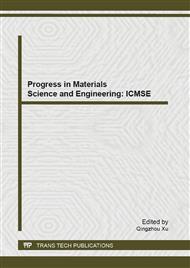[1]
C. W. Tang and S. A. VanSlyke, Appl. Phys. Lett. 51, 913 (1987).
Google Scholar
[2]
J. P. Yang, Q. Y. Bao, Z. Q. Xu, Y. Q. Li, J. X. Tang, and S. Shen, Appl. Phys. Lett. 97, 223303 (2010).
Google Scholar
[3]
Feng Li, Xiao Li, Junhu Zhang, Bai Yang, Org. Electron. 8, 635 (2007).
Google Scholar
[4]
Z. B. Wang, M. G. Helander, X. F. Xu, D. P. Puzzo, J. Qiu, M. T. Greiner, and Z. H. Lu, J. Appl. Phys. 109, 053107 (2011).
Google Scholar
[5]
Yiru Sun and Stephen R. Forrest, Nature Photon. 2, 483 (2008).
Google Scholar
[6]
Ji-Hyang Jang, Min-Cheol Oh, Tae-Hoon Yoon, and Jae Chang Kim, Appl. Phys. Lett. 97, 123302 (2010).
Google Scholar
[7]
Z. B. Wang, M. G. Helander, J. Qiu, D. P. Puzzo, M. T. Greiner, Z. M. Hudson, S. Wang, Z. W. Liu and Z. H. Lu1, Nature Photon. 5, 753 (2011).
Google Scholar
[8]
Yu-Hung Cheng, Jia-Lin Wu, Chien-Hong Cheng, Kao-Chih Syao, and Ming-Chang M. Lee, Appl. Phys. Lett. 90, 091102 (2007).
Google Scholar
[9]
G. Gu, D.Z. Garbuzov, P.E. Burrows, S. Venkatesh, S.R. Forrest, M.E. Thompson, Opt. Lett. 22, 396 (1997).
Google Scholar
[10]
Sang-Hwan Cho, Young-Woo Song, Joon-gu Lee, Yoon-Chang Kim, Jong Hyuk Lee, Jaeheung Ha, Jong-Suk Oh, So Young Lee, Sun Young Lee, Kyu Hwan Hwang, Dong-Sik Zang and Yong-Hee Lee, Opt. Express. 16, 12637 (2008).
DOI: 10.1109/ivmc.2003.1222972
Google Scholar
[11]
C. S. Kim, M. Kim, D. C. Larrabee, I. Vurgaftman, J. R. Meyer, S. H. Lee, and Z. H. Kafafi, J. Appl. Phys. 106, 113105 (2009).
Google Scholar
[12]
Soon Moon Jeong, Fumito Araoka, Yoshimi Machida, Ken Ishikawa, Hideo Takezoe, Suzushi Nishimura, and Goro Suzaki, Appl. Phys. Lett. 92, 083307 (2008).
DOI: 10.1063/1.2839897
Google Scholar
[13]
Yiru Sun and Stephen R. Forrest. J. Appl. Phys. 100, 073106 (2006).
Google Scholar
[14]
Jin Yeong Kim and Kyung Cheol Choi. J. Dis. Tech. 7, 377 (2011).
Google Scholar
[15]
Young Rag Do, Yoon-Chang Kim and Young-Woo Song, J. Appl. Phys, 96, 7629 (2004).
Google Scholar
[16]
Kuan-Yu Chen, Yung-Ting Chang, Yu-Hsuan Ho, Hoang-Yan Lin, Jiun-Haw Lee, and Mao-Kuo Wei, Opt. Express. 18, 3238 (2010).
DOI: 10.1109/jdt.2010.2104134
Google Scholar
[17]
Michael Slootsky and Stephen R. Forrest1, Appl. Phys. Lett. 94, 163302 (2009).
Google Scholar


